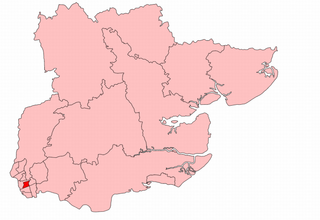Related Research Articles

Horsham is a constituency represented in the House of Commons of the UK Parliament, centred on the eponymous town in West Sussex, its former rural district and part of another rural district. Its Member of Parliament (MP) was Francis Maude between 1997 and 2015; since then it has been Jeremy Quin, both of the Conservative Party.
New Forest and Christchurch was a county constituency in Hampshire which elected one Member of Parliament (MP) to the House of Commons of the Parliament of the United Kingdom. It was created for the 1918 general election, partially replacing the previous New Forest constituency, and was abolished for the 1950 general election, when it was partially replaced by a recreated New Forest constituency.
Altrincham was a county constituency of the House of Commons of the Parliament of the United Kingdom from 1885 to 1945. It elected one Member of Parliament (MP) by the first past the post system of election.

Fulham West was a borough constituency based in the London district of Fulham. It was represented in the House of Commons of the Parliament of the United Kingdom from 1918 to 1955.

Rossendale was a parliamentary constituency in the Lancashire, England. Created in 1885, it elected one Member of Parliament (MP) to the House of Commons of the Parliament of the United Kingdom, elected by the first-past-the-post voting system. When created it comprised the districts of Rawtenstall, Bacup, and Haslingden; Ramsbottom district was added to the constituency in 1950.

Henry Graham White, known as Graham White, was a radical British Liberal Party politician.

Upton was a parliamentary constituency in the Borough of West Ham in the South-West of Essex, which returned one Member of Parliament (MP) to the House of Commons of the Parliament of the United Kingdom, elected by the first past the post voting system.
Ilford was a borough constituency in what is now the London Borough of Redbridge in eastern Greater London. It returned one Member of Parliament (MP) to the House of Commons of the Parliament of the United Kingdom. It was created for the 1918 general election, and abolished for the 1945 general election, when it was replaced by the new Ilford North and Ilford South constituencies.

Consett was a county constituency, centred on the town of Consett in County Durham. It returned one Member of Parliament (MP) to the House of Commons of the Parliament of the United Kingdom, elected by the first past the post voting system from 1918 to 1983.

Mile End was a parliamentary constituency centred on the Mile End district of the East End of London. It returned one Member of Parliament (MP) to the House of Commons of the Parliament of the United Kingdom.
Leeds North was a borough constituency in the city of Leeds, West Yorkshire, which returned one Member of Parliament (MP) to the House of Commons of the Parliament of the United Kingdom, elected by the first past the post voting system.
Tottenham North was a parliamentary constituency centred on the Municipal Borough of Tottenham, in North London. It returned one Member of Parliament (MP) to the House of Commons of the Parliament of the United Kingdom.
Oldham was a parliamentary constituency centred on the town of Oldham, England. It returned two Members of Parliament (MPs) to the House of Commons of the Parliament of the United Kingdom. The constituency was created by the Great Reform Act of 1832 and was abolished for the 1950 general election when it was split into the Oldham East and Oldham West constituencies.
Rutland and Stamford was a county constituency comprising the area centred on the town of Stamford in Lincolnshire, and the county of Rutland. It returned one Member of Parliament (MP) to the House of Commons of the Parliament of the United Kingdom, using the first-past-the-post voting system.
Leyton West was a parliamentary constituency in the Municipal Borough of Leyton – then part of Essex but now in Greater London. It returned one Member of Parliament (MP) to the House of Commons of the Parliament of the United Kingdom, elected by the first past the post system.

Bow and Bromley was a constituency in the Parliament of the United Kingdom. Located in the Metropolitan Borough of Poplar in London, it was created by the Redistribution of Seats Act for the 1885 general election and returned one Member of Parliament (MP) until it was abolished for the 1950 general election.
Edward Albert Lessing OBE was a British corn trader, Liberal Party politician and an early authority on Soviet Russia.
Rothwell was a parliamentary constituency centred on the Rothwell area of West Yorkshire. It returned one Member of Parliament (MP) to the House of Commons of the Parliament of the United Kingdom, elected by the first past the post system.
The 1921 Louth by-election was a by-election held on 22 September 1921 for the British House of Commons constituency of Louth in Lincolnshire.

Robert Leonard Outhwaite,, known as R. L. Outhwaite, was a radical British Liberal Party politician, Member of Parliament and leading advocate of land reform.
References
- ↑ British Parliamentary Election Results 1918-1949, FWS Craig
- ↑ Debrett's House of Commons and the Judicial Bench
- ↑ ‘RODOCANACHI, Emmanuel Michel’, Who Was Who, A & C Black, an imprint of Bloomsbury Publishing plc, 1920–2016; online edn, Oxford University Press, 2014 ; online edn, April 2014 accessed 15 Sept 2017
- ↑ British Parliamentary Election Results 1918-1949, FWS Craig
- ↑ British Parliamentary Election Results 1918-1949, FWS Craig
- ↑ British Parliamentary Election Results 1918-1949, FWS Craig
- ↑ British Parliamentary Election Results 1918-1949, FWS Craig
- ↑ British Parliamentary Election Results 1918-1949, FWS Craig
- ↑ British Parliamentary Election Results 1918-1949, FWS Craig
- ↑ Report of the Annual Conference of the Labour Party, 1939
- Craig, F. W. S. (1983) [1969]. British parliamentary election results 1918-1949 (3rd ed.). Chichester: Parliamentary Research Services. ISBN 0-900178-06-X.
- Leigh Rayment's Historical List of MPs – Constituencies beginning with "H" (part 4)